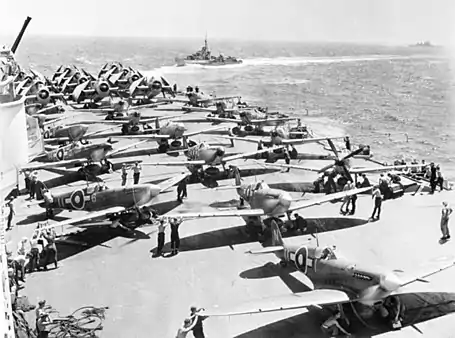| 8th Carrier Air Group | |
|---|---|
 | |
| Active | 30 June 1945 to April 1946[1] |
| Country | |
| Branch | |
| Type | Carrier Air Group |
| Size | One Implacable-class aircraft carrier plus support ships |
| Part of | Fleet Air Arm |
| Engagements | World War II |
The 8th Carrier Air Group (8th CAG) was an aircraft carrier air group of the Royal Navy's Fleet Air Arm. It was formed in June 1945, for service in the British Pacific Fleet, until disbanding the following year, in April 1946. The group was embarked on HMS Implacable (R86).[2]
Naval Air Squadrons
The 8th Carrier Air Group consisted of a number of squadrons of the Fleet Air Arm.[1]
| Squadron | From | To | Aircraft |
|---|---|---|---|
| 828 Naval Air Squadron | Jun 1945 | Apr 1946 | Grumman TBF Avenger |
| 801 Naval Air Squadron | Jun 1945 | Apr 1946 | Supermarine Seafire |
| 880 Naval Air Squadron | Jun 1945 | Sep 1945 | Supermarine Seafire |
| 1771 Naval Air Squadron | Jun 1945 | Sep 1945 | Fairey Firefly |
History
1945 - 1946

The 8th Carrier Air Group of the Fleet Air Arm was formed on 30 June 1945, for the name ship of her class, the aircraft carrier HMS Implacable, for service in the British Pacific Fleet. It was made up of 828 Naval Air Squadron which operated the Grumman TBF Avenger, an American torpedo bomber, 801 Naval Air Squadron and 880 Naval Air Squadron, which were equipped with Supermarine Seafire, a navalised Supermarine Spitfire fighter aircraft, and 1771 Naval Air Squadron which flew the Fairey Firefly, a carrier-borne fighter and anti-submarine aircraft.
The group flew off eight Fairey Firefly and a dozen Supermarine Seafire aircraft, from HMS Implacable, against targets north of Tokyo on 17 July, however, due to bad weather only the Fairey Firefly were able to locate their targets. Eight Fairey Firefly and twenty Supermarine Seafire aircraft attacked targets near Tokyo the following day, however, more bad weather halted flying operations. On the 24–25 July, Fleet Air Arm aircraft resumed attacks, crippling the escort carrier Kaiyo.[3]
With the atomic bombing of Hiroshima and more bad weather, the group was unable to operate between the end of July and the 9 August. However, on that day, the CAG flew 94 x Supermarine Seafire sorties and flew 14 x Fairey Firefly sorties off HMS Implacable, against targets in northern Honshu and southern Hokkaido, with the loss of two Supermarine Seafire aircraft. On the 10 August, the sorties continued, sinking two warships, various small merchantmen and destroying railroad locomotives and dispersed aircraft.[4] The CAG aircraft flew over 1,000 sorties since their arrival, the previous month.[5]
In September 1945, 880 Naval Air Squadron was absorbed by 801 Naval Air Squadron, and also 1771 Naval Air Squadron disbanded. The 8th Carrier Air Group was disbanded in April 1946.[1]
Air Group Commanders
List of commanding officers of the 8th Carrier Air Group, with date of appointment:[1]
See also
References
Citations
- 1 2 3 4 Ballance 2016, p. 306.
- ↑ Wragg 2019, p. 203.
- ↑ Hobbs 2011, p. 261, 263, 266, 267.
- ↑ Hobbs 2011, p. 273–81, 286–287, 410.
- ↑ Hobbs 2013, p. 110.
Bibliography
- Sturtivant, R; Ballance, T (1994). The Squadrons of The Fleet Air Arm. Tonbridge, Kent, UK: Air-Britain (Historians) Ltd. ISBN 0-85130-223-8.
- Ballance, Theo (2016). The Squadrons and Units of the Fleet Air Arm. Air-Britain. ISBN 978-0-85130-489-2.
- Wragg, David (2019). The Fleet Air Arm Handbook 1939-1945. Cheltenham, Gloucestershire, UK: The History Press. ISBN 978-0-7509-9303-6.
- Hobbs, David (2011). The British Pacific Fleet: The Royal Navy's Most Powerful Strike Force. Annapolis, Maryland: Naval Institute Press. ISBN 978-1-59114-044-3.
- Hobbs, David (2013). British Aircraft Carriers: Design, Development and Service Histories. Barnsley, UK: Seaforth Publishing. ISBN 978-1-84832-138-0.